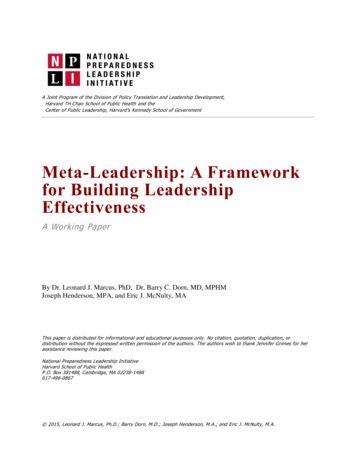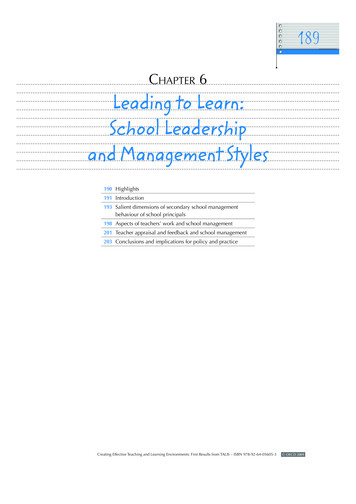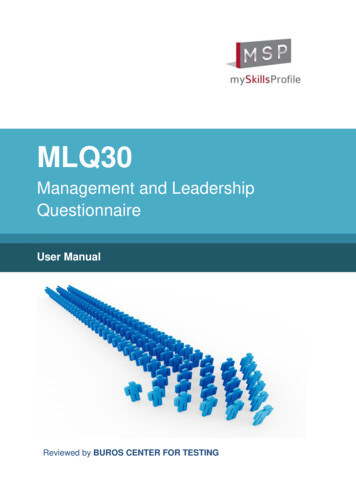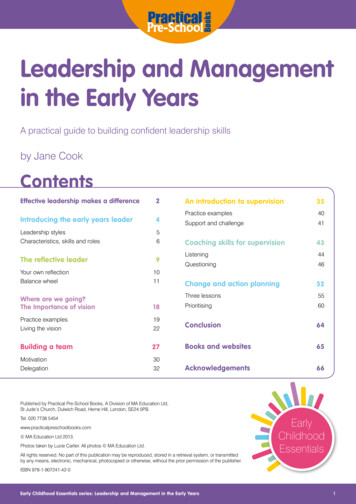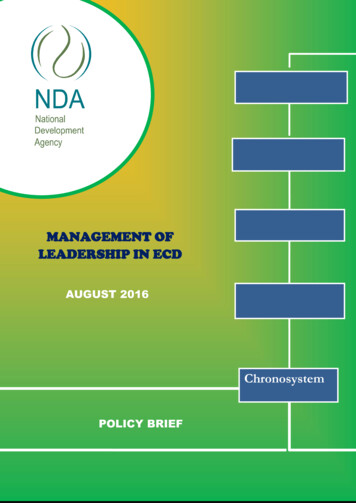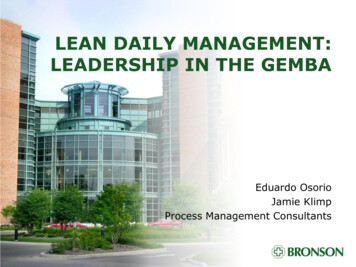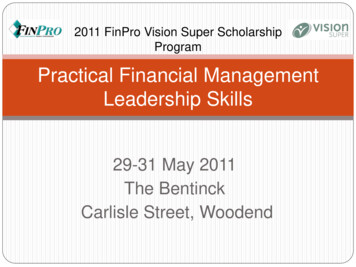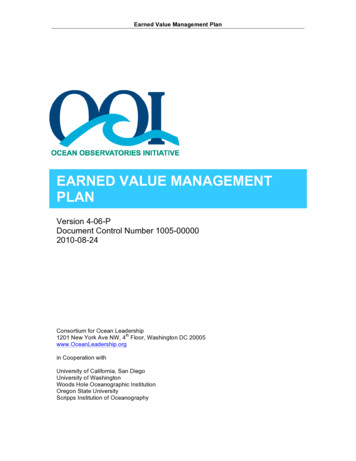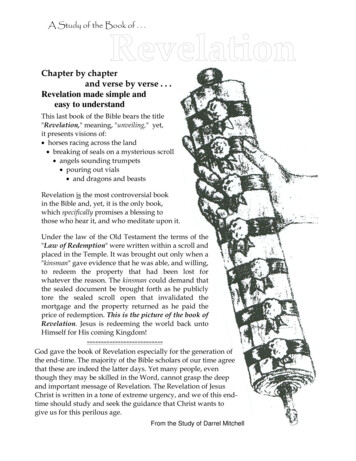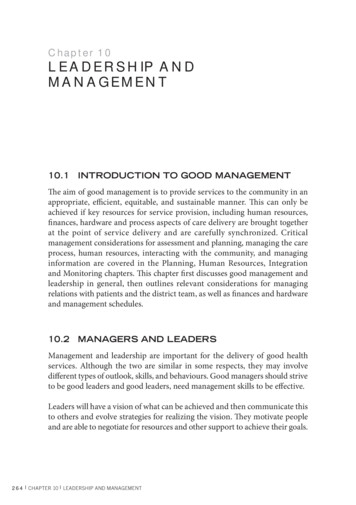
Transcription
Chapter 10LEADERSHIP ANDMANAGEMENT10.1 INTRODUCTION TO GOOD MANAGEMENTThe aim of good management is to provide services to the community in anappropriate, efficient, equitable, and sustainable manner. This can only beachieved if key resources for service provision, including human resources,finances, hardware and process aspects of care delivery are brought togetherat the point of service delivery and are carefully synchronized. Criticalmanagement considerations for assessment and planning, managing the careprocess, human resources, interacting with the community, and managinginformation are covered in the Planning, Human Resources, Integrationand Monitoring chapters. This chapter first discusses good management andleadership in general, then outlines relevant considerations for managingrelations with patients and the district team, as well as finances and hardwareand management schedules.10.2 MANAGERS AND LEADERSManagement and leadership are important for the delivery of good healthservices. Although the two are similar in some respects, they may involvedifferent types of outlook, skills, and behaviours. Good managers should striveto be good leaders and good leaders, need management skills to be effective.Leaders will have a vision of what can be achieved and then communicate thisto others and evolve strategies for realizing the vision. They motivate peopleand are able to negotiate for resources and other support to achieve their goals.264 l CHAPTER 10 l LEADERSHIP AND MANAGEMENT
Managers ensure that the available resources are well organized and applied toproduce the best results. In the resource constrained and difficult environmentsof many low – to middle-income countries, a manager must also be a leaderto achieve optimum results.What are the attributes of a good leader? Leaders often (but not necessarilyalways): have a sense of mission; are charismatic; are able to influence people to work together for a common cause; are decisive; use creative problem solving to promote better care and a positive workingenvironment.Leadership is creating a visionManagers who have these leadership qualities are a credit to the services theymanage. However managers must ensure that day-to-day processes run wellto produce the desired results. Certain attributes are required for a managerto be effective, including: clarity of purpose and tasks; good organizational skills; ability to communicate tasks and expected results effectively; ability to negotiate various administrative and regulatory processes; good delegation skills.Management is getting things doneOPERATIONS MANUAL FOR STAFF AT PRIMARY HEALTH CARE CENTRES l 265
10.3 CONDITIONS FOR GOOD MANAGEMENTCertain conditions are important for creating good management, including: managers and team members need to be selected on merit; managers need to earn the respect of their staff, patients, and supervisors; managers need to have the knowledge, skills and understanding of the role,tasks and purpose of the services they deliver; basic support systems function well; clear staff administration rules andregulations; well planned and timely delivered supplies, equipment and drugs;clear and transparent financial processes; and well planned and monitoredactivities.Management is getting things done through balanced involvement of peopleAs a health facility manager there are important questions to discuss with thedistrict management team and to ask yourself: What exactly am I supposed to do as a manager? Will the resources needed be here and be on time? How free am I to take decisions, e.g. to move staff around? How can I balance my managerial and clinical duties? How can I reduce the time spent on the many routine reports I need towrite? What and where are the tools and techniques to help me do the job well?Conditions for being an effective manager are best when these questions haveclear and positive answers so that tasks are clear, the delegation of authority isknown and managers know where and when to seek support for their decisions.Management also flourishes when the manager and the staff agree about theobjectives of the work that they are doing, and can make decisions easily andwith minimal risks.266 l CHAPTER 10 l LEADERSHIP AND MANAGEMENT
10.4 HOW TO LEARN AS A MANAGERHealth care delivery and patient circumstances are constantly changing,and managers have to continue to learn new abilities and skills to keep up.A significant portion of management involves skills and competencies suchas motivating staff, communicating and negotiating with stakeholders, andmaintaining certain attitudes and behaviours that maximize staff discipline andperformance. Managers also need to understand the basic technical aspects ofthe services delivered. For most of these competencies, training courses, whileeffective, are often not sufficient to provide all the necessary skills.How can managers create and foster an environment in which they, and thepeople they manage, are constantly learning? One way is to clearly and regularlyidentify challenges that the service faces, and the skills and knowledge that theteam needs to overcome these challenges. The ways to acquire the necessaryskills and competencies may include: continuous education and learning (including self-learning programmes) structured “academic” courses; the most common form of managementtraining; Secondments, attachments, shadowing/observation and study tours providepractical learning and examples of how others handle situations you will likelyface; Mentoring and coaching relationships – experienced mentors provide insightsinto managing partnerships and relationships, opportunities to seek adviceand explore options when managers are faced with difficult situations; Peer to peer learning – an opportunity to meet other managers at regularintervals, share experiences, challenges and solutions, build a commonunderstanding of processes, and to support each other.Other peer learning techniques include: Learning cycles/groups - groups of team members who meet regularly todiscuss issues and help develop or improve management systems;OPERATIONS MANUAL FOR STAFF AT PRIMARY HEALTH CARE CENTRES l 267
Networks – managers from within and outside your health centre with acommon interest in understanding and improving their situation; Reflection sessions – managers and their teams set aside a regular time toreview their work, identify areas that need improvement, and ways to improvethe service;These methods can be used by the managers as part of their planned selfdevelopment, and should be linked to challenges they face in deliveringservices. Every manager needs clear learning objectives and plans and availabletime for these activities (e.g. put aside a half day every two weeks for team orpersonal learning).10.5 OVERVIEW: A MANAGER’S ROLE AND TASKSCertain roles and responsibilities all general managers need to manage,include: type and coverage of services to be delivered; resources (staff, budgets, drugs and supplies, equipment, buildings and otherinfrastructure and information) available for use; people, including patients, partners, suppliers and staff that are importantfor delivering functional quality services.The specific functions carried out by health facility managers are discussedhere and in other chapters, However, no matter what type of service is offered,managers need to devise and implement strategies, make plans and budgets,seek resources, implement, monitor and evaluate the plans, learn lessons, andthen design new plans.A manager delegates some tasks to other staff members and supports andcoaches them to achieve desired results. Managers use team and staff meetingsand other forms of communication to communicate the appropriate messagesto staff about what is to be achieved and how.268 l CHAPTER 10 l LEADERSHIP AND MANAGEMENT
A major management task is reviewing the important information and dataconcerning service delivery and using this data to make decisions about howservices can be modified and improved. Managers are responsible for thefinances available to the service, ensuring that these are used to produce themaximum possible benefits for patients and staff. Keeping a firm focus onthe overall goal of the service and reminding staff, partners and clients of thisgoal is a major task for managers. Management involves developing staff/skills mentoring persons with high potential, and resolving conflicts whilemaintaining ethics and disciplineManagers must also develop “management improvement/action plans” thattarget: difficulties in management systems bottlenecks/barriers to service delivery tasks that need to be delegated, and expected results of the management functions.Management is about making decisions10.6 HOW TO MANAGE RELATIONS WITH THEDISTRICT TEAM/ SUPERVISORIn most health systems, health facilities are linked to thenational health system through the district and threfore areaccountable to district management teams. All operationalhealth system activities are implemented via the districtincluding drugs and commodities procurement, humanresources, infrastructure, and technical support. Local facilitymanagers and district managers must have clear lines of communication, andensure optimal off-site support and supervision, and that reporting to districtsis accurate.District Team SupportOPERATIONS MANUAL FOR STAFF AT PRIMARY HEALTH CARE CENTRES l 269
Facility managers must communicate all challenges to the district level tomake sure there is continued service delivery at facility level. District managersshould communicate new policies and management tools to local managersto ensure compliance. A strong relationship between the two levels is key tosustained service delivery at the facility level.10.7 HOW TO MANAGE PATIENT RELATIONS ANDACHIEVE PATIENT SATISFACTIONHealth facilities exist for the sole purpose of providing health services topatients in communities. Therefore managers need to ensure that clientsatisfaction is of utmost importance. This is why all staff must be trained tounderstand patients’ rights.CommunityStaff should not be judgmental and must provide informationto patients so they can make informed decisions regardingtreatment options, as well as lifestyle and behaviourmodifications that may be required to improve their healthstatus. Staff must also be able to assist patients to understandtheir responsibilities, including: to live a healthy lifestyle; not to participate in risky behaviour; to participate in their care by attending appointments, asking questions, andplaying a part in their own health improvement; to be open and honest about the problems they face; to have the best health outcome by adhering to treatment regimes.The attitude of staff towards patients influences patients’ willingness to obtainaccess to and continue care, to treatments, and to accept and follow healthpromotion messages. Negative staff attitudes reduce patients’ self esteem andmotivation, reducing their will to seek services.270 l CHAPTER 10 l LEADERSHIP AND MANAGEMENT
Assessing patient satisfactionAppropriate tools should be used by the health centre and district supervisorsto assess patient satisfaction, or to assess how patients perceive the healthestablishment in general. These include: client satisfaction surveys suggestion boxes community consultation committees.These concrete measures ensure patients’ voices are heard. Anonymousmechanisms for eliciting suggestions should be encouraged, such as a“suggestion box” placed in the waiting area (with paper and pen), in whichpatients can put anonymous messages. The box should be emptied regularlyand comments discussed with the staff.10.8 PATIENTS’ RIGHTSPatients’ rights, include the right to:1.2.3.4.5.6.health informationfull range of accessible and affordable health servicesprivacy when they are receiving health carebe treated with dignity and respect when they are receiving health carebe assured that personal information will remain confidentialbe given an explanation of the processes that they go through when they are receivinghealth care7. be treated by people who are trained and knowledgeable about what they do8. continuity of services9. be treated by a named provider10.express the views on the services provided and to complain about unsatisfactory healthservices11. gender equality12. a healthy and safe environment13. make free informed choicesOPERATIONS MANUAL FOR STAFF AT PRIMARY HEALTH CARE CENTRES l 271
10.9 HOW TO MANAGE FINANCESThe degree to which health centres are involved in managing funds andfinancial resources varies with the nature of the health centre, its size, and thestructure of the national health services. Yet, all health services have to managetwo types of funds: “Invisible funds”, or budgetary allocation. These are not physically handled,but represent a “credit” that is provided by the district management team orother entity that will handle how they are spent; “Visible money” or cash: This money is seen and handled in the centre. Moneycan be kept for spending (usually small in amounts, called “petty cash”1), orbe received for services or sales of goods.Managing money and finances in a health centre is complex and responsiblework. Ultimately, the facility manager bears responsibility for the correcthandling of all financial aspects. Good financial management is the core of goodservice delivery. The facility manager needs to ensure that financial resourcesare committed to those activities that contribute to organizational goals.Regular use of the good financial management checklist below can help ensurethat the financial procedures in place conform to good financial practises.1Petty cash – the financial term for this is imprested fund272 l CHAPTER 10 l LEADERSHIP AND MANAGEMENT
A good financial management checklist ensures that: All accounting registers, journals and ledgers are up to date.All financial reports are prepared and submitted in a timely manner.Procedures for the use of petty cash are properly developed.All expenses other than petty cash are paid by cheque.Financial activities are separated in such a way that one person alone never registers,reviews and authorizes any complete transaction.Procedures for authorizing purchases are being followed.Security measures are in place to protect the assets, books and registers from tamperingor theft.A physical inventory of fixed assets and supplies is conducted at least once a year.The bank statement is reconciled monthly.There is a financial plan and/or a financial strategy leading to improved cost recovery.Financial administration staff is involved in both programme and financial planningprocesses.A realistic annual budget is developed from the work plan.The organization has a unified budget, as well as sub-budgets for different programmesand/or donors. The accounting system adequately allocates expenses to differentprogrammes and/or donors.The line items in the chart of accounts, the budget and management financial reportscorrespond with each other.Cash flow is adequately monitored and is projected for the year so there are no periodsof cash shortage.Actual expenditures are compared quarterly with the budget and corrective action istaken as a result of these comparisons.Often, health centres have no dedicated financial officers to handle budgets andfinancial control is exerted by the overall facility manager. A minimum set offinancial management tasks includes: budget preparation and cash flow projection budget allotments and expenditures management of cash income and expenses financial monitoring and reporting the use of financial information to make decisions.OPERATIONS MANUAL FOR STAFF AT PRIMARY HEALTH CARE CENTRES l 273
How to prepare a budget and cash flow projectionA health centre budget outlines how financial resources will be used over adefined period of time, usually one year. Two main steps in budget preparationinclude projecting all expenses that will be incurred at the health centre, andmatching them with expected revenues and budget allocations. Additionalcash flow projections help to ensure that income and expenditure matchthroughout the year, and the health centre is able to meet costs as they incur.Budget development is an essential part of the planning process.Determining resource needs and associated costsThe starting point for budgeting is a list of the resources needed to carry outall activities throughout the year required to maintain the health centre and toprovide its services. It is useful to also list resources that are directly providedto the centre and that are financed from other budgets (e.g. staff or medicationpaid directly by the district authorities). Leaving out these in-kind contributionshides the real cost of services delivery, and makes it hard to determine how tomake the service sustainable in the future. The budget includes two types ofresource needs and costs: Fixed costs: remain constant and are independent from the exact level ofactivity within the capacity of the centre. Such costs include most salaries,equipment leases or payments, rent and utilities. Some fixed costs also changewith the level of activity – such as the number of staff needed. Variable costs: depend on the level of activity such as the number of patientstreated. Such costs include care consumables, drug costs and transportationcosts for home visits etc. Variable costs are usually specified “per unit” ofdelivery (e.g. drug needs and costs for one patient on first-line ART) andmultiplied by an estimated “number of units” (e.g. the number of patientsexpected to be on first-line ART in the facility).It is recommended to use a budgeting sheet (see Annex 10.1: Budget Sheet)and to sub-divide the list of resources into various categories. For eachresource (e.g. staff ), you need to specify the type of costs associated (e.g. salary)and time period, (usually 12 months), and at what cost per unit (e.g.US 300 Dollars (USD) per month). Standard categories are recommended274 l CHAPTER 10 l LEADERSHIP AND MANAGEMENT
by district authorities and ideally the same categories are used for budgeting,accounting and reporting. Those categories may include: staff; physical infrastructure and building operating costs; medical supplies, equipment and consumables; communication; transportation including vehicle operating costs and travel; replacement costs (depreciation) – This is a provision for long-term assets(such as vehicles/machinery/computers/lab equipment) that deteriorate overtime and have to be replaced at the end of their usefulness. Some moneyneeds to be set aside every year for future purchases to replace these assets(see section - 10.10 - Managing Hardware).Determining funding sourcesFor many public programmes there will be only one source of funding, i.e.the district health service, or the provincial or national health department.However, some public facilities – and usually all private facilities – might alsoreceive private funding or charge fees to generate income.The “unified budget” prepared in the previous step will be of great help in managingincoming funds. This is because the same listing of activities and resource needscan be used to demonstrate which funds are used towards what purpose. This isa process of “earmarking” that will ensure that the use of funds remains withinthe originally intended purpose. It will also facilitate donor reporting. Assigningincoming funds to expenditures is best achieved by appending specific “donorcolumns” to the budgeting sheet. (Annex 10.1 -Budget Sheet)Projecting cash flowCash flow projections are needed to ensure that each month enough moneyis available (in cash or in the allotment) to cover all anticipated financialOPERATIONS MANUAL FOR STAFF AT PRIMARY HEALTH CARE CENTRES l 275
obligations. Cash flow projections are done on the basis of the health centre’sbudget, detailing the amount of expenditures, and when they occur. (See Annex10.2 Cash Flow Projection Sheet).Cash flow projections are best made for each month of the budget year, andshould outline: how much money is available a the beginning of the month; what funds will be received during the month; and How much money is expected to be spent during the month.The remaining balance should be zero or a positive amount and should be carriedforward to the next month. Prudent financial management requires that as partof cash flow processes, management fixed management costs be prioritized overother expenses; otherwise operations could be brought to a halt.How to manage allotments“Invisible money” is allocated to a health centre based on a budget (see previoussub-section) that defines certain expenditure categories. To keep track ofexpenditures against such allotments, a logbook of all expenditures should bekept that will allow the manager to track how much money has been spent, andhow much money is still available. This logbook is usually called “allotmentledger” (see Annex 10.3 – Allotment Ledger).In the ledger, the manager registers all fund allocations (credits) and allexpenditures (debits). For each transaction, the date is registered, as well as areference to further documentation on the transaction (see below). At any pointin time, the amount debited can be totalled and deducted from the amountcredited. The ledger can combine all expenditure categories, or break themdown according to main categories. Usually, the district office will provide aspecific format for such a ledger.Expenditures against allotments are made in the form of “purchase orders”or “vouchers”, that will allow the allotment holder (e.g. the district healthadministration) to make the payment. Each purchase order needs to be dulysigned at the health centre and by the health district administration. Purchase276 l CHAPTER 10 l LEADERSHIP AND MANAGEMENT
orders and payment vouchers are usually pre-printed and serially numbered(see Annex 10.4 – Purchase order / Voucher).Managers who have the responsibility of authorizing expenditures andpurchases need to ensure that; 1) the purchase is justified and within the scopeof planned activities; 2) the cost is competitive; 3) the transaction is properlydocumented, and; 4) sufficient funds are available to make the purchase.How to manage cashMost health centres need to have some reserves to cover small cash expenses(“petty cash”). This cash is advanced to the manager based on the budget, andsubtracted from the allotment. The provision of a cash advance for specificpurposes is called a “petty cash fund”. The types of expenses that can be coveredby the petty cash fund vary from place to place but may include: transportation such as bus fares, petrol; communication such as stamps and phone calls; cleaning needs such as soap, detergent; stationary such as paper, envelopes. sundries such as matches, candles, tea, emergency supplies.A petty cash fund is a fixed amount of cash (e.g. US 50) from disbursementsthat are made for the purchase of goods or services. The cash is kept in a safeplace to which only the manager has access. It is important that each time cashis taken out, the transaction is documented in a logbook (“petty cash book”),and supported by evidence for its use (“voucher” and “receipt”). When thepetty cash fund is nearing its exhaustion (e.g. after having spent US 40) themanager will total all expenditures. The remaining balance will be “broughtforward (B/F)” and the petty cash fund will be replenished to the original level(e.g. by adding US 40 to reach the original level of US 50).Petty cash books are usually standardized to list - (in table form) eachtransaction, the date, the purpose, the number of a referring voucher/purchaseorder, and the amount paid or received. It is possible to add additional columnsto break down expenses by certain categories (see Annex 10.5 - Petty CashOPERATIONS MANUAL FOR STAFF AT PRIMARY HEALTH CARE CENTRES l 277
Book). The voucher documenting each transaction is filled out when funds aregiven out and signed by both the authorizing officer and the receiving staff (e.g.the driver). It is important to attach the original receipt for expenditures to allpurchase orders and vouchers if possible (e.g. a receipt from a petrol station- see Annex 10.6 - Cash Voucher). Certain health centres may also receive cash,usually in form of service fees or from sales of drugs or other commodities. Foreach transaction, a receipt is issued in three duplicates: one for the client, oneto accompany the cash, and one that stays in the receipt book. Such receiptsare usually provided in the form of books of numbered receipts see Annex10.7 - Cash Receipt).Just as with expenditures, all cash revenues are kept in a safe place and arerecorded in a “revenue book” (see Annex 10.8 - Revenue Book), indicatingclearly for each transaction the date, amount, and purpose. Periodically, themanager will turn over funds to the district financial officer, together withcopies of used and unused receipts.How to report on the use of fundsThe manager is expected to show the appropriate use of finances and todemonstrate how their use relates to expenses set out in the work plan andbudget. One’s ability to do so depends on the availability of a well developedbudget and well kept up to date allotment records. In some cases, the facilitymanager will be able to complement records held at the health centre withofficial records and financial statements from the allotment holder (usually thedistrict administration). Implementation progress reports and financial reportsare normally required to comply with specific formats and to cover definedtime periods see Annex 10.9 - Financial Reporting Form).Financial controlsFinancial control procedures are essential for effective resource management.Even for a facility that employs accountants and other financial personnel, thefacility manager bears the ultimate responsibility for ensuring all resourcesentrusted to him or her are fully accounted for. It is important that thefacility puts in place guidelines, policies and rules and an effective financialcontrol system that ensures financial accountability see the good financialmanagement checklist). Finally, it is advisable that at least once a year, thefinancial transactions of the facility are audited.278 l CHAPTER 10 l LEADERSHIP AND MANAGEMENT
10.10 HOW TO MANAGE HARDWAREA number of tangible goods and structures are needed to successfully provideservices at the health centre, including: physical infrastructure and buildings equipment and machinery, including vehicles drugs, commodities and supplies.Various chapters in this manual describe how to design appropriate spacedistribution and use, how to choose and maintain laboratory equipment, andhow to plan for effective procurement of drugs and commodities. However, as amanager, you are expected to ensure that all of this hardware remains functionalall the time. To this end, you will need to make plans and reserve budget for: regular maintenance of all hardware, including machinery, vehicles, andbuildings; supplies to use hardware, such as test kits for lab equipment and petrol forvehicles; repair of failing hardware; replacement of hardware once it has reached a predefined period of use orfails beyond repair.From a practical point of view it is recommended that all maintenance andreplacement actions be marked in the yearly facility planner to avoid a lackof critical hardware in the centre (see below; How to design ManagementSchedules). In addition, if replacement hardware needs to be purchased bythe health centre, a budget allocation for “depreciation” of the hardware needsto be made.OPERATIONS MANUAL FOR STAFF AT PRIMARY HEALTH CARE CENTRES l 279
10.11 HOW TO DESIGN MANAGEMENTSCHEDULESThe facility manager is challenged to juggle a range of important managementresponsibilities and tasks, and at the same time to ensure the smooth running ofthe health centre. The key challenge for any manager is the limited availability oftime. A first step to managing your time as efficiently as possible is to examinehow your working time is actually spent. Normally, managers will spendsignificant portions of their time on: management and administrative tasks, including development of work plans,budgets and reports; meeting with health workers help them work better together as a team; meeting with patients, the community and other external partners; interacting with the district level authorities; travelling and attending of workshops; learning and continued education; clinical work.The challenge is to reduce time spent on lower priorities and to free time forpriority tasks that would otherwise be neglected. Some proven “time savers”and “time managers” are: learn to say “no” rationally delegate and distribute work within the team use meetings wisely; run meetings effectively have a strategy for dealing with interruptions be aware of time wasters.280 l CHAPTER 10 l LEADERSHIP AND MANAGEMENT
An important tool to use time effectively is to structure the work routine sothat important tasks receive specific, regular time slots. Recommended fixedtime slots include: health care team meetings supervisor briefings community meetings time for budget review time for report preparations.Successful managers use calendars and to-do lists to structure time demandsand to ensure that no important tasks are forgotten. Important tasks andevents are best kept on a yearly wall calendar, on which each line representsone month, with each day having one field. As a manager, you should includethe following information on this planner: important dates on which action on contractual issues is needed; absences ofteam members (participation in training, vacation); a time slot for a yearlypatient satisfaction survey, time for supervisory visits, and community healthcommittee meetings; managing information: time slots for preparation of routine patientmonitori
leadership in general, then outlines relevant considerations for managing relations with patients and the district team, as well as fi nances and hardware and management schedules. 10.2 MANAGERS AND LEADERS Management and leadership are important for the delivery of good health services. Al


